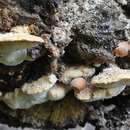fr
noms dans le fil d’Ariane


The Phanerochaetaceae are a family of mostly crust fungi in the order Polyporales.
Phanerochaetaceae was first conceived by Swedish mycologist John Eriksson in 1958 as the subfamily Phanerochaetoideae of the Corticiaceae.[2] It was later published validly by Erast Parmasto in 1986,[3] and raised to familial status by Swiss mycologist Walter Jülich in 1982. The type genus is Phanerochaete.[4]
In 2007, Karl-Henrik Larsson proposed using the name Phanerochaetaceae to refer to the clade of crust fungi clustered near Phanerochaete.[5] In 2013, a more extensive molecular analysis showed that the Phanerochaetaceae were a subclade of the large phlebioid clade, which also contains members of the families Meruliaceae and Irpicaceae.[6] The generic limits of Phanerochaete were revised in 2015,[7] and new genera were added in 2016.[8] As of April 2018, Index Fungorum accepts 30 genera and 367 species in the family.[9]
Most Phanerochaetaceae species are crust-like. Their hyphal system is monomitic (containing only generative hyphae), and these hyphae lack clamp connections. Their spores are thin-walled, smooth, and hyaline (translucent). Cystidia are often present in the hymenium. Although rare, some species have a polyporoid form, a dimitic hyphal system, and clamp connections. Phanerochaetaceae fungi produce a white rot.[1]
{{cite journal}}: Cite journal requires |journal= (help) {{cite journal}}: Cite journal requires |journal= (help) The Phanerochaetaceae are a family of mostly crust fungi in the order Polyporales.
Phanerochaetaceae è una famiglia di funghi basidiomiceti appartenente all'ordine Polyporales.
Phanerochaetaceae è una famiglia di funghi basidiomiceti appartenente all'ordine Polyporales.
Phanerochaetaceae is een botanische naam, voor een familie van schimmels. Volgens de Index Fungorum [15 maart 2009] bestaat de familie uit de volgende 23 geslachten: Amethicium, Antrodiella, Australicium, Australohydnum, Byssomerulius, Candelabrochaete, Ceraporus, Ceriporia, Ceriporiopsis, Climacodon, Hjortstamia, Hyphodermella, Inflatostereum, Membranicium, Meruliopsis, Meruliporia, Phanerochaete, Phlebiopsis, Porostereum, Pseudolagarobasidium, Rhizochaete, Roseograndinia en Terana. .
Phanerochaetaceae is een botanische naam, voor een familie van schimmels. Volgens de Index Fungorum [15 maart 2009] bestaat de familie uit de volgende 23 geslachten: Amethicium, Antrodiella, Australicium, Australohydnum, Byssomerulius, Candelabrochaete, Ceraporus, Ceriporia, Ceriporiopsis, Climacodon, Hjortstamia, Hyphodermella, Inflatostereum, Membranicium, Meruliopsis, Meruliporia, Phanerochaete, Phlebiopsis, Porostereum, Pseudolagarobasidium, Rhizochaete, Roseograndinia en Terana. .
Korownicowate (Phanerochaetaceae Jülich) – rodzina grzybów należąca do rzędu żagwiowców (Polyporales)[2].
Pozycja w klasyfikacji według Index Fungorum: Polyporales, Incertae sedis, Agaricomycetes, Agaricomycotina, Basidiomycota, Fungi[1].
Według aktualizowanej klasyfikacji Index Fungorum bazującej na Dictionary of the Fungi do rodziny tej należą rodzaje[3]:
Polskie nazwy na podstawie pracy Władysława Wojewody z 2003 r[4].
Korownicowate (Phanerochaetaceae Jülich) – rodzina grzybów należąca do rzędu żagwiowców (Polyporales).
The Phanerochaetaceae là một họ nấm thuộc bộ Polyporales.
The Phanerochaetaceae là một họ nấm thuộc bộ Polyporales.